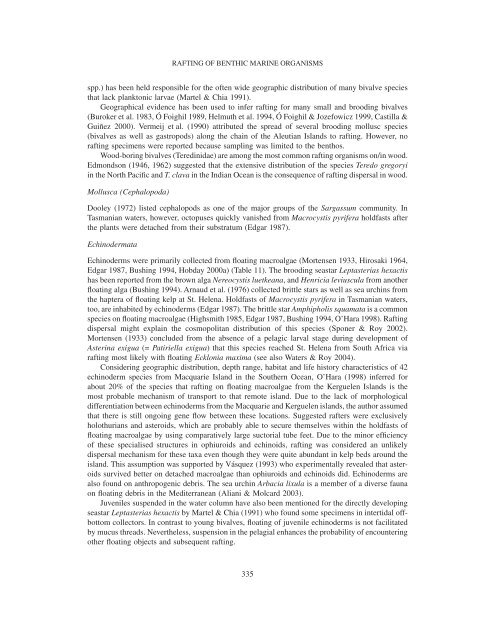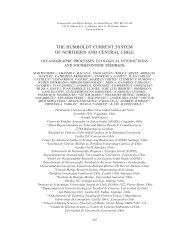The ecology of rafting in the marine environment - Bedim
The ecology of rafting in the marine environment - Bedim
The ecology of rafting in the marine environment - Bedim
Create successful ePaper yourself
Turn your PDF publications into a flip-book with our unique Google optimized e-Paper software.
RAFTING OF BENTHIC MARINE ORGANISMS<br />
spp.) has been held responsible for <strong>the</strong> <strong>of</strong>ten wide geographic distribution <strong>of</strong> many bivalve species<br />
that lack planktonic larvae (Martel & Chia 1991).<br />
Geographical evidence has been used to <strong>in</strong>fer <strong>raft<strong>in</strong>g</strong> for many small and brood<strong>in</strong>g bivalves<br />
(Buroker et al. 1983, Ó Foighil 1989, Helmuth et al. 1994, Ó Foighil & Jozefowicz 1999, Castilla &<br />
Guiñez 2000). Vermeij et al. (1990) attributed <strong>the</strong> spread <strong>of</strong> several brood<strong>in</strong>g mollusc species<br />
(bivalves as well as gastropods) along <strong>the</strong> cha<strong>in</strong> <strong>of</strong> <strong>the</strong> Aleutian Islands to <strong>raft<strong>in</strong>g</strong>. However, no<br />
<strong>raft<strong>in</strong>g</strong> specimens were reported because sampl<strong>in</strong>g was limited to <strong>the</strong> benthos.<br />
Wood-bor<strong>in</strong>g bivalves (Tered<strong>in</strong>idae) are among <strong>the</strong> most common <strong>raft<strong>in</strong>g</strong> organisms on/<strong>in</strong> wood.<br />
Edmondson (1946, 1962) suggested that <strong>the</strong> extensive distribution <strong>of</strong> <strong>the</strong> species Teredo gregoryi<br />
<strong>in</strong> <strong>the</strong> North Pacific and T. clava <strong>in</strong> <strong>the</strong> Indian Ocean is <strong>the</strong> consequence <strong>of</strong> <strong>raft<strong>in</strong>g</strong> dispersal <strong>in</strong> wood.<br />
Mollusca (Cephalopoda)<br />
Dooley (1972) listed cephalopods as one <strong>of</strong> <strong>the</strong> major groups <strong>of</strong> <strong>the</strong> Sargassum community. In<br />
Tasmanian waters, however, octopuses quickly vanished from Macrocystis pyrifera holdfasts after<br />
<strong>the</strong> plants were detached from <strong>the</strong>ir substratum (Edgar 1987).<br />
Ech<strong>in</strong>odermata<br />
Ech<strong>in</strong>oderms were primarily collected from float<strong>in</strong>g macroalgae (Mortensen 1933, Hirosaki 1964,<br />
Edgar 1987, Bush<strong>in</strong>g 1994, Hobday 2000a) (Table 11). <strong>The</strong> brood<strong>in</strong>g seastar Leptasterias hexactis<br />
has been reported from <strong>the</strong> brown alga Nereocystis luetkeana, and Henricia leviuscula from ano<strong>the</strong>r<br />
float<strong>in</strong>g alga (Bush<strong>in</strong>g 1994). Arnaud et al. (1976) collected brittle stars as well as sea urch<strong>in</strong>s from<br />
<strong>the</strong> haptera <strong>of</strong> float<strong>in</strong>g kelp at St. Helena. Holdfasts <strong>of</strong> Macrocystis pyrifera <strong>in</strong> Tasmanian waters,<br />
too, are <strong>in</strong>habited by ech<strong>in</strong>oderms (Edgar 1987). <strong>The</strong> brittle star Amphipholis squamata is a common<br />
species on float<strong>in</strong>g macroalgae (Highsmith 1985, Edgar 1987, Bush<strong>in</strong>g 1994, O’Hara 1998). Raft<strong>in</strong>g<br />
dispersal might expla<strong>in</strong> <strong>the</strong> cosmopolitan distribution <strong>of</strong> this species (Sponer & Roy 2002).<br />
Mortensen (1933) concluded from <strong>the</strong> absence <strong>of</strong> a pelagic larval stage dur<strong>in</strong>g development <strong>of</strong><br />
Aster<strong>in</strong>a exigua (= Patiriella exigua) that this species reached St. Helena from South Africa via<br />
<strong>raft<strong>in</strong>g</strong> most likely with float<strong>in</strong>g Ecklonia maxima (see also Waters & Roy 2004).<br />
Consider<strong>in</strong>g geographic distribution, depth range, habitat and life history characteristics <strong>of</strong> 42<br />
ech<strong>in</strong>oderm species from Macquarie Island <strong>in</strong> <strong>the</strong> Sou<strong>the</strong>rn Ocean, O’Hara (1998) <strong>in</strong>ferred for<br />
about 20% <strong>of</strong> <strong>the</strong> species that <strong>raft<strong>in</strong>g</strong> on float<strong>in</strong>g macroalgae from <strong>the</strong> Kerguelen Islands is <strong>the</strong><br />
most probable mechanism <strong>of</strong> transport to that remote island. Due to <strong>the</strong> lack <strong>of</strong> morphological<br />
differentiation between ech<strong>in</strong>oderms from <strong>the</strong> Macquarie and Kerguelen islands, <strong>the</strong> author assumed<br />
that <strong>the</strong>re is still ongo<strong>in</strong>g gene flow between <strong>the</strong>se locations. Suggested rafters were exclusively<br />
holothurians and asteroids, which are probably able to secure <strong>the</strong>mselves with<strong>in</strong> <strong>the</strong> holdfasts <strong>of</strong><br />
float<strong>in</strong>g macroalgae by us<strong>in</strong>g comparatively large suctorial tube feet. Due to <strong>the</strong> m<strong>in</strong>or efficiency<br />
<strong>of</strong> <strong>the</strong>se specialised structures <strong>in</strong> ophiuroids and ech<strong>in</strong>oids, <strong>raft<strong>in</strong>g</strong> was considered an unlikely<br />
dispersal mechanism for <strong>the</strong>se taxa even though <strong>the</strong>y were quite abundant <strong>in</strong> kelp beds around <strong>the</strong><br />
island. This assumption was supported by Vásquez (1993) who experimentally revealed that asteroids<br />
survived better on detached macroalgae than ophiuroids and ech<strong>in</strong>oids did. Ech<strong>in</strong>oderms are<br />
also found on anthropogenic debris. <strong>The</strong> sea urch<strong>in</strong> Arbacia lixula is a member <strong>of</strong> a diverse fauna<br />
on float<strong>in</strong>g debris <strong>in</strong> <strong>the</strong> Mediterranean (Aliani & Molcard 2003).<br />
Juveniles suspended <strong>in</strong> <strong>the</strong> water column have also been mentioned for <strong>the</strong> directly develop<strong>in</strong>g<br />
seastar Leptasterias hexactis by Martel & Chia (1991) who found some specimens <strong>in</strong> <strong>in</strong>tertidal <strong>of</strong>fbottom<br />
collectors. In contrast to young bivalves, float<strong>in</strong>g <strong>of</strong> juvenile ech<strong>in</strong>oderms is not facilitated<br />
by mucus threads. Never<strong>the</strong>less, suspension <strong>in</strong> <strong>the</strong> pelagial enhances <strong>the</strong> probability <strong>of</strong> encounter<strong>in</strong>g<br />
o<strong>the</strong>r float<strong>in</strong>g objects and subsequent <strong>raft<strong>in</strong>g</strong>.<br />
335










